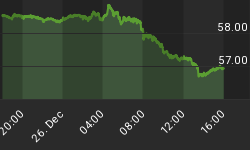Any psychoanalyst looking at the behavior of investors today would see clear strains of schizophrenia in a comparison between the markets for gold and US Treasuries.
Currently, the 10-year Treasury yield is setting new lows on a daily basis. In the financial models all economists were taught at school, this would be an indication of an economy with low inflation expectations and a strong currency. But the dollar has fallen over 12% since June, and the price of gold continues to hit all-time highs. These results are completely antithetical. Bonds are flashing a warning sign of deflation, while gold and the dollar presage hyperinflation.
During the last period in which the US experienced significant economic stress, the late 70's and early 80's, the markets in gold and Treasuries showed a much higher degree of harmony. At that time, the Fed's extreme depression of interest rates led to rapidly rising inflation, a weakening dollar, and a massive spike in the price of gold. More significantly, yields on Treasuries soared as investors demanded higher rates as compensation for the added inflation risk. In other words, everything made sense.
Beginning in January of 1977, gold began an epic bull market which ended just prior to February of 1980. In that time, the metal soared from $135 per ounce to just under $860 per ounce, and the Dollar Index lost about 20% of its value. Yields on the 10-year Treasury soared from 7.2% in January of 1977 to 12.4% in February of 1980. This occurred in an environment where the Federal Reserve - under Arthur Burns - pursued an inflationary monetary policy. He increased the monetary base from $62 billion to $114 billion in just eight years.
Today, the environment is similar to what the country confronted 30 years ago. Like then, our monetary base has surged - but this time even faster. Instead of merely doubling in eight years as it did under Burns' watch, Alan Greenspan and Ben Bernanke have tripled the base in twelve years (from $621 billion in 2000 to over $2 trillion today). Accordingly, the dollar price of gold has more than quadrupled, from $280 per ounce in 2000 to over $1,300 today. Over that time, the dollar has registered a 35% drop in value. However, in stark contrast to 1980, the yield on the 10-year Treasury note has collapsed from 6.6% in 2000 to less than 2.4% today.
A nation should only be able to enjoy ultra-low interest rates if it has a high savings rate, stable monetary policy, low inflation, and very low levels of debt. The US savings rate, which had been range-bound between 7.5% and 15% during the '60s and '70s, now stands at just 5.8%. And that rate reflects recent belt-tightening in the wake of the credit crunch. The personal savings rate had been negligible and sometimes negative from 1998 thru 2008. Washington's current annual budget deficit is 9% of GDP and the national debt is 93% of GDP. And, of course, the Fed has - in its own words - undertaken "unconventional measures" to push up inflation. Therefore, none of the conditions that should engender low interest rates currently exist.
Clearly both gold and the US dollar agree that Ben Bernanke will be victorious in his quest to foment robust inflation. But Treasury investors seem to believe that despite its current inflationary disposition, the Fed will be able to either: A) hold down interest rates for an extended period or B) withdraw its liquidity before things get out of hand. To take this position, one would have to not only believe that the forex and gold markets have it wrong, but also think that the Fed's printing press will lose its power to depreciate the currency. This is a seriously misguided set of assumptions.
Bernanke asserts that the Fed brought on the Great Depression by allowing the money supply to contract by 30% after the Crash of 1929. He has also written that the Depression relapse of 1937 stemmed from Washington's attempt to balance the budget and raise interest rates. Therefore, I can reasonably assume that he will not stop the presses until inflation has a firm and undeniable grip on the American economy.
Many currently believe that 'Helicopter Ben' has yet to ignite inflation on the ground because the money he dropped from the sky is still stuck in the trees. In other words, the funds are caught in the banking system and not spreading among the populace. Yet, M1 is up 6.2% YoY; and, in the last two months, the compounded annual rate of change in M2 is 7.4%. Although these single-digit increases do not yet indicate runaway inflation, a program of relentless quantitative easing has a conclusion as predictable as driving 100mph around an icy mountain turn. Since the Chairman has shown no will to hit the brakes, you'd have to be mad to ride the yield curve alongside him.
For in-depth analysis of this and other investment topics, subscribe to Euro Pacific's Global Investor Newsletter. Click here for your free subscription.
Click here to download Euro Pacific's Special Report: My Five Favorite Gold & Silver Mining Stocks.
Be sure to pick up a copy of Peter Schiff's just-released economic fable, How an Economy Grows and Why It Crashes.
















